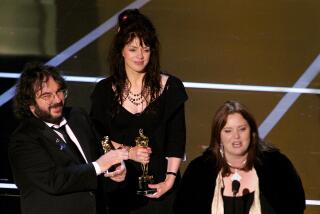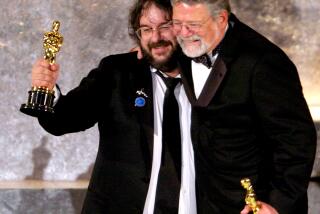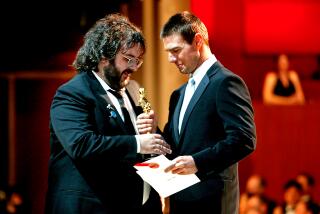A royal wrap-up to ‘Rings’ trilogy
- Share via
The Lord of the Rings -- The Return of the King (Platinum Series Special Extended Edition)
New Line, $40
The two previous extended editions of Peter Jackson’s “Lord of the Rings” films -- “The Fellowship of the Ring” and “The Two Towers” -- were sterling examples of what a special digital edition of a movie could and should be.
Each was filled with extended and deleted scenes and commentaries and tons of informative, well-produced featurettes. The trend continues with this four-disc set of the last installment of the J.R.R. Tolkien trilogy, the leading candidate for the best special-edition set of the year.
Of course, you’ll need hours and hours to experience the extended edition. With the deleted and extended scenes, the movie clocks in at a heady 4 hours, 10 minutes, and there are four commentary tracks and six hours of documentary featurettes. It’s best to savor this edition over a couple of days. It may just be too much to watch in one sitting.
The new scenes: Perhaps the most important footage that has been reinstated for this special edition is a seven-minute sequence in which Christopher Lee’s evil Saruman meets a very violent end. Originally the scene was filmed for “The Two Towers” but was omitted because it impeded the flow of that film. When the scene didn’t seem to fit seamlessly into “Return of the King,” either, Jackson tried everything to make it work and even called Lee back to the set for a series of reshoots. Still, Jackson wasn’t satisfied and cut the scene from “Return of the King,” much to the dismay of the veteran actor Lee. (In his audio commentary on “Return of the King,” there is still a bit of rancor in Lee’s voice about being left out of the film.)
So did Jackson make the right decision?
Yes and no. The Saruman sequence does slow the action in what is already a very long film, but it does bring closure to the character, and fans will enjoy the flamboyant way in which he meets his end.
Saruman’s death isn’t the only scene shot for “The Two Towers” that was repurposed for “Return of the King.” The whole opening sequence of “King,” which depicts how Smeagol found the ring and was transformed into the wretched Gollum, was originally supposed to be in “Two Towers” after the scene in which Sam tells Gollum about his real identity.
Jackson loved the scene but thought it interrupted the main story. So when it came time to plan the opening of “Return of the King,” Jackson thought the Smeagol sequence would be the perfect bookend to the trilogy. Screenwriter and Jackson significant other Fran Walsh helmed most of that sequence.
And when she got sick, Andy Serkis, who plays Smeagol/Gollum, took over.
Extras
The four audio commentaries are terrific, each offering a different view of the making of this film as well as the trilogy. Jackson, Walsh and co-writer Philippa Boyens supply one track. The design team, including Grant Major, Nigila Dickson, Richard Taylor and Alan Lee, talks about the look of the film. There’s also commentary from members of the production/postproduction team and from cast members including Elijah Wood, Sean Astin, Billy Boyd, Dominic Monaghan, Orlando Bloom, Ian McKellen and Serkis (who offers commentary as Smeagol and Gollum).
Discs 3 and 4 are “The Appendices” to “Return of the King” -- a stream of documentaries covering all aspects of the production, including “J.R.R. Tolkien: The Legacy of Middle-earth,” “From Book to Script -- Forging the Final Chapter,” “Designing Middle-earth,” “Costume Design,” “Home of the Horse Lords,” which looks at the equine training, “New Zealand as Middle-earth,” “Camera in Middle-earth,” “Music for Middle-earth” and “Editorial: Completing the Trilogy.”
Get out your hankies for the final documentary, “Cameron Duncan: The Inspiration for ‘Into the West,’ ” a profile in courage about the late teenage New Zealand filmmaker whose courageous battle with cancer became the inspiration for the Oscar-winning tune “Into the West.” Duncan demonstrated a startling maturity in his short films, and his story is both heartbreaking and inspiring. The documentary also includes his short films.
More to Read
Only good movies
Get the Indie Focus newsletter, Mark Olsen's weekly guide to the world of cinema.
You may occasionally receive promotional content from the Los Angeles Times.











